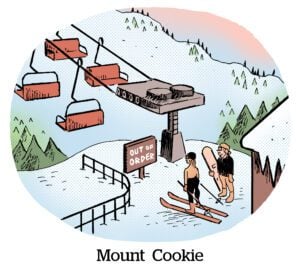US advertisers have been preparing for the cookieless future for years. States like California, Virginia, Colorado and others have already enacted or have pending data-privacy legislation. This patchwork of rules will redefine the US online advertising ecosystem in 2024.
But what does the death of the cookie actually mean for agencies and publishers?
Welcome to Scandi-Land, where the cookieless future has been our online media reality for the last five years. Together, the Scandinavian countries of Denmark, Norway and Sweden have been operating in a microcosm of strict privacy regulation and cookie depletion – much like what’s currently spreading across the US.
Here are three lessons for media planners, buyers, sellers and platforms who are going to have a tough time navigating the thicket of change.
Direct deals pose a threat to the open web
While programmatic bidding has been the backbone of online advertising, stringent data-protection laws are forcing a reevaluation of this model. That’s bad news for the open web, as the rising tide of privacy regulations will continue pushing advertisers and publishers toward more direct deals.
In Europe, we witnessed a similar trend as the General Data Protection Regulation (GDPR) came into effect in 2018. Advertisers sought more control over their data and partnerships with trusted publishers. This led to a surge in direct deals.
In the US, a similar shift is inevitable. Direct relationships are the simplest way to ensure compliance with higher levels of data security required by privacy legislation.
The push for privacy will also be a boon to the walled gardens: Apple, Google, Meta and Amazon. Privacy will become “productized.” The gardens will increasingly get to define privacy and make it available only within their black boxes. The result: further consolidation under the big players and the stifling of innovation.
However, there’s some good news – at least if you’re on the sell side. Direct sales will shift control back to publishers. Losing third-party audiences means advertisers will need to rely more on first-party data. There is a real opportunity for publishers to bring value to advertisers with their own audiences.
But there’s also some bad news for the sell side.
A decline in digital marketing dollars … for publishers
The introduction of robust privacy regulations can have an immediate impact on marketing spending. Four years ago, McKinsey & Co. expected a 10% decline in marketing spending in Europe following the implementation of GDPR.
However, in 2021, IAB Europe reported an annual growth of 30.5% in digital advertising, with 28 markets posting double-digit growth. This growth rate was the highest since 2008, adding €21.5 billion to the digital advertising market. And the European ad market grew another 9.8% in 2022, adding €7.7 billion.
While GDPR’s effect on ad spend seems to have been short-lived, it did push more spending from the open web to private and guaranteed.
And, although spending has remained strong, signal loss from third-party cookie deprecation bodes ill for publisher revenues. On iOS/Safari, which has blocked cookies since 2017, anonymous and unconsented visitors on average generate an eCPM that is 63% lower when compared to publishers’ addressable inventory, according to FouAnalytics.
True, publisher prices don’t directly correlate to overall ad spending, though the observably lower eCPMs on iOS do indicate that cookieless audiences are perceived as having lesser value. This drop in average eCPMs despite higher overall spending by marketers should be a warning to US publishers.
The decline in cookieless eCPMs has many causes, including the increased difficulty in targeting users with personalized ads, a shift toward more conservative and compliant strategies and a need for thorough consent management.
As privacy regulations gain traction in the US, advertisers will need to allocate budgets to adapt to the evolving landscape. These budgets will likely include investments in compliance tools, enhancing first-party data strategies and rethinking data-driven advertising.
Still, these declines should be viewed as a temporary adjustment. As always, publishers’ best bet to prove their value to advertisers is to remain relevant to their audiences.
Untracked solutions
The demise of third-party cookies and the limitations on user tracking necessitate a return to older but effective advertising strategies. In Europe, ad platforms have been forced to get more creative with offline analytics that can be applied to digital. Even offline demographic data has started to make a comeback.
Connecting real-life profiles to virtual ones tends to result in more sustainable and substantive targeting. That’s why contextual targeting has experienced a European revival and the power of household characteristics has been rediscovered.
While cookies were prevalent, contextual targeting seemed outdated; in 2024, the reverse will be true, as the methods that most respect user privacy win.
Will a shift to untracked targeting mean we’ll see a rise in publishers pushing “premium” inventory? That depends on the wider ad market and economic conditions, as well as how well publishers can translate direct sales into higher-value offerings. But the chances of sellers extracting more premium dollars from marketers increases as spend shifts to direct deals.
“Data-Driven Thinking” is written by members of the media community and contains fresh ideas on the digital revolution in media.
Follow Digiseg and AdExchanger on LinkedIn.


















